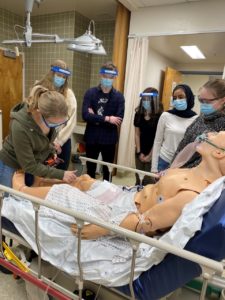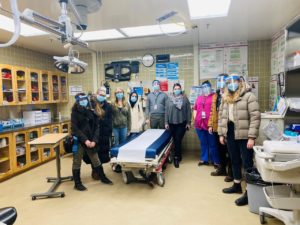For communities in Northern Alberta, attracting health professionals, and retaining them once they are there, can be a challenge.
That’s why a new collaboration between Alberta Health Services (AHS) and the University of Calgary is so welcome in High Level and Fort Vermilion.
“We’ve always brought in one or two students from different universities, but this is the first time that the University of Calgary has partnered with us and the first time that we’ve brought in a cohort of six (nursing students),” said Angie Mann, AHS director of clinical operations, Area 1.
Spurred on by open discussions around the hurdles facing rural and remote health care, the members of the Faculty of Nursing at the University of Calgary reflected on their department’s needs, given their increased enrollment.

– Photo supplied by AHS
The university proposed sending multiple students at a time as an opportunity to support the needs of both the school and AHS.
At the same time, it also provides students with a unique learning experience.
“It shows the impact that can be made if institutions, such as the U[niversity] of C[algary] and AHS, work together on a common goal,” said Dr. Zahra Shajani, Associate Dean of Undergraduate Practice Education of the University’s Faculty of Nursing.
“Our goal is to provide students with meaningful clinical experiences to build their competency for entry level as a registered nurse (RN). AHS’s goal is to recruit and retain RNs and be able to make sure that they’re feeling comfortable and competent. This is definitely a win-win.”
With both the school and AHS on board, the next step was to see what the level of interest was like among students, and what questions or concerns they had about living and working less than 200 km from the Northwest Territories.
“I think that was the biggest thing, gauging how many students really would have been interested in this experience,” shared Shajani, adding that they had 15 students submit applications for the opportunity.
It shows the impact that can be made if institutions, such as the U[niversity] of C[algary] and AHS, work together on a common goal. Our goal is to provide students with meaningful clinical experiences to build their competency for entry level as a registered nurse (RN). AHS’s goal is to recruit and retain RNs and be able to make sure that they’re feeling comfortable and competent. This is definitely a win-win.
-Dr. Zahra Shajani, Associate Dean of Undergraduate Practice Education of the University’s Faculty of Nursing.
“Our goal is to provide students with meaningful clinical experiences to build their competency for entry level as a registered nurse (RN). AHS’s goal is to recruit and retain RNs and be able to make sure that they’re feeling comfortable and competent. This is definitely a win-win.”

“I think it was more about working with the students and … AHS to make it really happen. We didn’t just [pick students and send them]; we worked together and sent students that really wanted to go.”
Originally intending to send a group of four, the organizers added additional spots after seeing the level of interest.
After deciding on a group of six, split between High Level and Fort Vermilion, the selected nursing students headed north in mid-January where they would live and work alongside their classmates. The fact that they went as a group also offered support for the students who were far from home, family, and friends.
“It just eases your anxiety and stress, because you know someone who’s in the same position as you,” reflected Paige Hutton on what it meant to have other University of Calgary students there.
“It’s definitely a different lifestyle and a completely different outlook on the profession up here. It’s a lot of learning, which is great, but it can be overwhelming, especially if you’re on your own.”
We need to try new things to get new results. This is a perfect example of how thinking outside the box has really supported recruitment and retention, a long-standing challenge in the north.
-Angie Mann, AHS director of clinical operations, Area 1.
For Hutton, one of the things that attracted her to rural medicine was the unique challenges she would face working in remote communities. The busy work-life set against the slow pace of remote living intrigued her, but the reality was more than she imagined.
“It definitely went beyond my expectations,” said Hutton, who lived and worked in Fort Vermilion during her preceptorship. “I [knew] it was going be challenging, but I didn’t realize how much I would get to do.”
“I like being able to work with my full scope; there’s just so much I get to do that I wouldn’t get to do in the city,” she said, sharing that this was one of the reasons she decided to stay on after her preceptorship ended.
“I’m always on my toes, always learning. It keeps my mind open. I love nursing here.”
I like being able to work with my full scope; there’s just so much I get to do that I wouldn’t get to do in the city.
-Paige Hutton, University of Calgary student
One of the four students who chose to stay on and continue working in the community, Hutton says she has since moved to High Level, and will be working at both the Northwest Health Centre and St. Theresa General Hospital in Fort Vermilion.
Encouraged and excited by the enthusiasm students had for the northern communities, and the number who stayed behind to start their careers, both AHS and the University of Calgary say they look forward to finding more ways to work together.
“We really have an opportunity here to look at this experience and how well it has gone,” says Shajani. “As we move forward, we’re definitely open to [new] opportunities, but these experiences have to be meaningful…. [T]he biggest learning piece has been that we have to work collaboratively.”
“We need to try new things to get new results,” adds Mann, reflecting on the success of this initiative. “This is a perfect example of how thinking outside the box has really supported recruitment and retention, a long-standing challenge in the north.”
Did you enjoy this article?
Subscribe to the Rural Health Beat to get an article about positive developments in rural health delivered to your inbox each week.
Oops! We could not locate your form.
